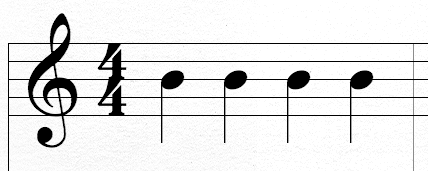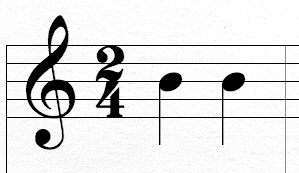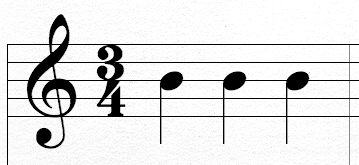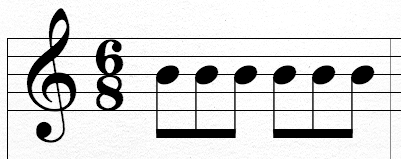Learning how to write down music in traditional notation can seem difficult, often requiring a few years of good ear training practice. But it needn’t be so hard! Read on to learn some of the basics of rhythm and notation, find great musician resources, and test your rhythm skills.
Basic Rhythm Theory
As you are sitting reading this article, take a moment and feel your pulse – or watch the secondhand of a watch. If your heartbeat is steady and slow it is probably around 60-70 BPM (or beats per minute), or one beat every time a second ticks away on your clock.
If that steady pulse represented single beats in a 4/4 measure, it would look like this:

Basic music notation relies on subdivisions and symbols to represent notes on paper.
While it may seem complicated to understand, if you can add 2+2, then you can notate music!
Here is a simple mathematical breakdown:
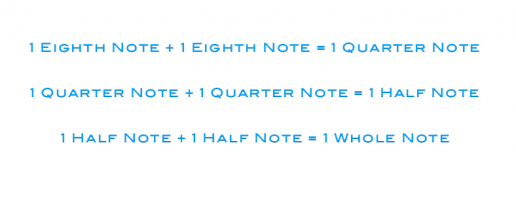
Watch these two short informative videos to learn more about music theory subdivisions then continue reading for more helpful ear training resources. In these two videos you will find out more about how rhythm works, how to notate rhythm, and how to count each beat in a measure. These are useful tools when trying to understand the basics of rhythmic notation. In the next Rhythm training article you will learn common rhythms and their music notation.
Watch more videos on rhythm here.
Ear Training Exercise 1: Count Out Loud
Listen to the 60 BPM example again. As each beat passes, practice saying “1-2-3-4”, with each number falling on each beat played. These are quarter notes. It takes four quarter notes for each beat in a 4/4 measure.
Now listen to this example of 8th notes, or two notes per beat:
As you listen, the 8th note (drum part) plays two notes per second. The notation for a measure of 8th notes looks like this:
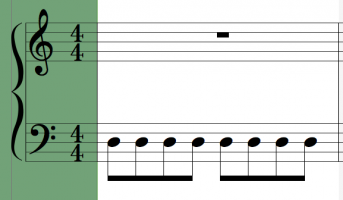
Listen to the 8th note example again. On the first listen, tap out the 8th note rhythm. The second time, count “1&2&3&4&” . This is how you count 8th notes when listening to music.
Rest Easy
Along with each beat and subdivision of the beat having its own individual symbol, silence also has a symbol! These are called “rests”.
A quarter rest is worth one beat: 
An 8th rest is worth half of a beat:

In the drumbeat example below you will hear quarter notes and eighth notes. Listen to the rhythm. Try to tap it from memory with your drumsticks. Look at the notation example while the rhythm plays and use your ear training skills to hear where the rhythm stops and starts.

A Note About Time Signatures
You may have noticed that you can easily count “1-2-3-4” to the music on the radio. This is because the time signature is 4/4, or four quarter notes for every measure.
In a time signature, the top number tells you how many beats per measure while the bottom number tells you which note gets the beat.
If a 4 is on the bottom, like in 4/4 time, the quarter note gets the beat.
If an 8 is on the bottom, like in 6/8 time, the 8th note gets the beat.
There are many other notes that can get the primary beat, but in most popular music you will find that either the quarter note or the 8th note receives the beat.
Here are a few other examples of common time signatures:
Two quarter notes per measure. Many marches are in 2/4 time.
Three quarter notes per measure. These songs usually have a waltz feel to them.
Six 8th notes per measure. In 6/8, you often count this as two groups of three “1-2-3, 4-5-6” and conduct it in two. Every genre from rock to classical has some songs in 6/8 time.
Learn more about music theory and time signatures by watching this helpful video from Dave Conservatoire:
Ear Training Exercise 2: Rhythm Quiz
Practice your rhythm ear training skills with these six sound examples.
Each example will start out with four quarter notes, followed by a rhythm using 8th notes, quarter notes, quarter rests, and eighth rests. The examples progress in difficulty. Each example will be played once.
- Listen to the rhythm example three times
- Tap the rhythm from memory
- Listen again
- Count out the rhythms using numbers and subdivisions (ex. 1&2&3-4)
- Write out the rhythms on a piece of paper
- Scroll down to the end of the article to see the answers to each example
Find more online rhythm quizzes here.
Ear Training Exercise 3: Practice with a Friend
Continue practicing rhythm with your friends. Find a friend who can read music. One person plays a rhythm and the other notates it. Start with simple rhythms then work up to more complex rhythms. Your friend can work on ear training skills and you can hone your music notation skills.
Useful Tools for Music Notation
Whether you are old school and like to write music with pencil, paper, and a piano or opt for more recent music notation software programs, you can use many useful notation programs to help you write sheet music. The biggest benefit to music notation software is the ability to playback the music that you write. While it is not advisable to only write using a computer, if you are just learning about music theory and music notation, using a software program can help you figure out the rhythms that you need for your next song, or even help you create a great beat.
Finale Notepad
Download a free version of Finale Notepad, a simple and easy-to-use notation program that will help you learn the basics of music notation. Write simple sheet music, scores, and playback what you write. Finale PrintMusic and the full version of Finale are excellent software program for the music professional.
Noteflight
Another easy-to-use music notation software program, Noteflight is not as intuitive as Finale Notepad, but does have the benefit of being available online and encouraging a sharing community of musicians.
Sibelius
Sibelius and Finale lovers have had a historic debate as heated as the Mac vs. PC debate, but it really is a matter of preference.
Musescore
Free music notation software that can be downloaded to your computer quickly. While not as advanced as its big brothers Sibelius and Finale, freeware programs like Musescore can help musicians learn the basics of notation without spending a lot of money.
Summary
There are many ways to learn how to use your ear training skills to notate rhythms. The exercises above are just a brief introduction to the world of writing rhythm!
Continue to practice playing back simple rhythms, try online quizzes, read more about music theory, listen, and work with your friends.
Rhythm Quiz Answers
1. 
2. 
3. 
4. 
5. 
6. 
Further Rhythm Notation Resources
Ear Expansion Course Rhythm Module
Try the Rhythm module from this fun and easy ear training course that helps you get your rhythm and groove!
Music Theory Rhythm Resources
A simple explanation of meter and rhythm.
DigiDrummer
A useful app that gives you drum kits for your iPhone. Rhythm on the go!
Become a Rhythm Guru with GarageBand in 5 Easy Steps
Use Garageband to learn new rhythms.



